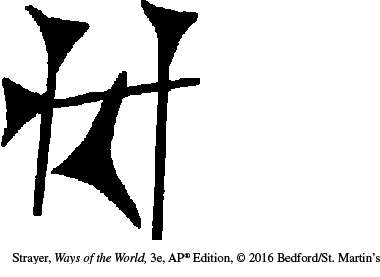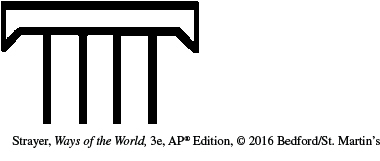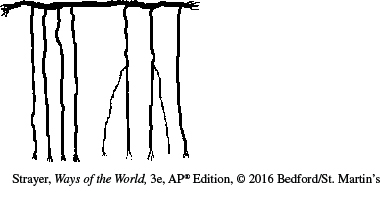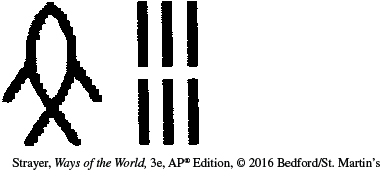Writing and Accounting
AP® EXAM TIP
You will be expected to know at least one form of early record keeping (writing), such as cuneiform from Mesopotamia.
A further support for state authority lay in the remarkable invention of writing. It was a powerful and transforming innovation, regarded almost everywhere as a gift from the gods, while people without writing often saw it as something magical or supernatural. Distinctive forms of writing emerged in most of the First Civilizations (see Snapshot: Writing in Ancient Civilizations), sustaining them and their successors in many ways. Literacy defined elite status and conveyed enormous prestige to those who possessed it. For Egyptians, a scribe earned a kind of immortality through his writing, for it persisted long after his death. Because it can be learned, writing also provided a means for some commoners to join the charmed circle of the literate. Writing as propaganda, celebrating the great deeds of the kings, was prominent, especially among the Egyptians and later among the Maya. A hymn to the pharaoh, dating to about 1850 B.C.E., extravagantly praised the Egyptian ruler:
78
He has come unto us … and has given peace to the two Riverbanks
and has made Egypt to live; he hath banished its suffering;
he has caused the throat of the subjects to breathe
and has trodden down foreign countries;
he has delivered them that were robbed; he has come unto us, that we may [nurture up?] our children and bury our aged ones.15
SNAPSHOT: Writing in Ancient Civilizations
Most of the early writing systems were logophonetic, using symbols to designate both whole words and particular sounds or syllables. Chinese characters, which indicated only words, were an exception. None of the early writing systems employed alphabets.
| Location | Type | Initial Use | Example | Comment |
| Sumer | Cuneiform: wedge-shaped symbols on clay tablets representing objects, abstract ideas, sounds, and syllables | Records of economic transactions, such as temple payments and taxes |
bird |
Regarded as the world’s first written language; other languages such as Babylonian and Assyrian were written with Sumerian script |
| Egypt | Hieroglyphs (“sacred carvings”): a series of signs that denote words and consonants (but not vowels or syllables) | Business and administrative purposes; later used for religious inscriptions, stories, poetry, hymns, and mathematics |
rain, dew, storm |
For everyday use, less formal systems of cursive writing (known as hieratic and demotic) were developed |
| Andes | Quipu: a complex system of knotted cords in which the color, length, type, and location of knots conveyed mostly numerical meaning | Various accounting functions; perhaps also used to express words |
numerical data (possibly in codes), words, and ideas |
Widely used in the Inca Empire; recent discoveries place quipus in Caral some 5,000 years ago |
| Indus River Valley | Some 400 pictographic symbols representing sounds and words, probably expressing a Dravidian language currently spoken in southern India | Found on thousands of clay seals and pottery; probably used to mark merchandise |
6 fish |
As yet undeciphered |
| China | Oracle bone script: pictographs (stylized drawings) with no phonetic meaning | Inscribed on turtle shells or animal bones; used for divination (predicting the future) in the royal court of Shang dynasty rulers |
horse |
Direct ancestor of contemporary Chinese characters |
| Olmec | Signs that represent sounds (syllables) and words; numbering system using bars and dots | Used to record the names and deeds of rulers and shamans, as well as battles and astronomical data |
jaguar |
Structurally similar to later Mayan script; Olmec calendars were highly accurate and the basis for later Mesoamerican calendars |
79
In Mesopotamia and elsewhere, writing served an accounting function, recording who had paid their taxes, who owed what to the temple, and how much workers had earned. Thus it immensely strengthened bureaucracy. Complex calendars indicated precisely when certain rituals should be performed. Writing also gave weight and specificity to orders, regulations, and laws. Hammurabi’s famous law code, while correcting certain abuses, made crystal clear that fundamental distinctions divided men and women and separated slaves, commoners, and people of higher rank.
AP® EXAM TIP
You must know that all early civilizations built monuments, such as the Egyptian pyramids, the huge Olmec stone heads, and the Babylonian palaces.
Once it had been developed, writing, like religion, proved hard to control and operated as a wild card in human affairs. It gave rise to literature and philosophy, to astronomy and mathematics, and, in some places, to history, often recording what had long been oral traditions. On occasion, the written word proved threatening, rather than supportive, to rulers. China’s so-called First Emperor, Qin Shihuangdi (r. 221–210 B.C.E.), allegedly buried alive some 460 scholars and burned their books when they challenged his brutal efforts to unify China’s many warring states, or so his later critics claimed (see Chapter 3). Thus writing became a major arena for social and political conflict, and rulers have always sought to control it.





